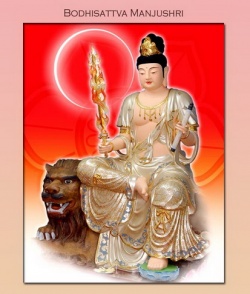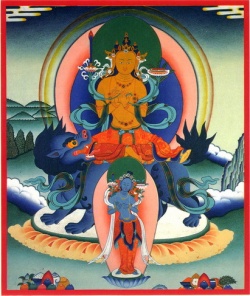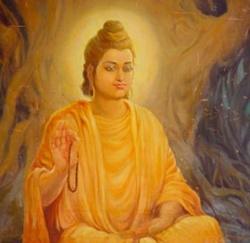Early Buddhist Sutras
The Ghandaran (in Gāndhāri) Buddhist texts are the oldest manuscripts yet discovered, dating from about the 1st century CE. They are written in Gāndhāri, and are possibly the oldest extant Indic texts altogether. They were sold to European and Japanese institutions and individuals, and are currently being recovered and studied by several universities. The Ghandaran texts are in a considerably deteriorated form (their survival alone is extraordinary), but educated guesses about reconstruction have been possible in several cases using both modern preservation techniques and more traditional textual scholarship, comparing previously known Pali and Sanskrit versions of texts. Other Gandhāran Buddhist texts—"several and perhaps many"—have been found over the last two centuries, but lost or destroyed.
The texts are attributed to the Dharmaguptaka sect by Richard Salomon, the leading scholar in the field, and the British Library scrolls "represent a random but reasonably representative fraction of what was probably a much larger set of texts preserved in the library of a monastery of the Dharmaguptaka sect in Nagarāhāra."
The Nikayas and the Agamas are the early Buddhist suttras which contain what the Buddha had taught for 45 years, including His fundamental teachings about the Four Noble Truths, Dependent Origination, and No Self. Many Buddhist scholars and historians usually consider these suttras the most authentic and reliable sources of what the Buddha actually taught.
After the Second Buddhist Council (100 years after the Buddha's demise), the first two schools Sthaviravada/Sthaviravadin (Thuong toa/Truong lao bo) and Mahasamghika (Dai chung bo) of the original Sangha continued to rely on these suttras to disseminate Buddhism orally. Later, these first two early schools split into further divisions, and ended up numbering, traditionally, about 18 or 20 schools.
The Sthaviras later divided into other schools such as the Sarvastivada (Nhat thiet huu bo) school and the Vibhajjavada (Phân biệt thuyết bộ, Sanskrit: Vibhajyavāda) school. The resultant Vibhajjavāda branch gave rise to a number of schools such as the Tāmraparnīya (later called Theravada), the Dharmaguptara school, the Mahisasaka school, and the Kasyapiya school. The Mahasamghika was divided into: Ekavyaharaka, Lokottaravada, Bahusrutiya, Prajnaptivada, and Caitika.
The five Nikayas were not recorded in any written form even though they had been thoroughly reviewed and considered complete by the Tamrasatiyah (Đồng diệp bộ) sect, which belonged to the Vibhajyavada (Phân biệt thuyết bộ, the name of the Theravada school at the time) during the Third Buddhist Council. These suttras continued to be orally disseminated in Sri Lanka by Mahinda until the Fourth Theravada Buddhist Council (83 BC), when they were recorded on palm leaves for the first time.
According to Robert Thurman, the term Nikaya Buddhism was coined by Dr. Masatoshi Nagatomi (Harvard University), in order to find a more acceptable and more neutral way than "Hinayana" to refer to the early Buddhist schools and their practice. Nikaya is also a term used in Theravada Buddhism to refer to a subschool or subsect within Theravada.
The five Nikayas suttras include:
the Dīgha Nikāya, the collection of long (Pāḷi: dīgha) discourses
the Majjhima Nikāya, the collection of middle-length (majjhima) discourses
the Samyutta Nikāya, the collection of thematically linked (samyutta) discourses
the Anguttara Nikāya, the "gradual collection" (discourses grouped by content enumerations)
the Khuddaka Nikāya, the "minor collection"
[Trường bộ kinh (Digha - Nikàya), Trung bộ kinh (Majhima - Nikàya), Tương ưng bộ kinh (Samyutta - Nikàya), Tăng chi bộ kinh (Anguttara - Nikàya), Tiểu bộ kinh (Khuddaka - Nikàya)]
During the Fourth (Mahayana) Buddhist Council, which took place around the second century AD under King Kanishkha, the Agamas, the Vinayas, and some Buddhist treatises were recorded in written form for the first time.
Āgama refers to a collection of discourses of early Buddhism preserved in Chinese. Sanskrit, Gāndhāri, and Tibetan translation. Sometimes āgama is used to refer to a class of scripture. Its meaning can encompass the Sutta-pitaka, which the Theravada tradition holds to be the oldest and most historically accurate representation of the teachings of Buddha, together with the Vinaya-pitaka.
There are four extant collections of āgamas, and one for which we have only references and fragments (the Kṣudrakāgama). The four extant collections are preserved in their entirety only in Chinese translation (āgama: 阿含經), although small portions of all four have recently been discovered in Sanskrit, and portions of four of the five āgamas are preserved in Tibetan.
These āgama sutras correspond to the first four Nikayas (and parts of the fifth) of the Pitaka of the Pali Canon. In this sense, āgama is a synonym for one of the meanings of nikaya. The āgamas have been compared to the Pali Canon's Nikayas by contemporary scholars in an attempt to identify possible changes and root phrasings. The āgamas' existence and similarity to the Sutta Pitaka are sometimes used by scholars to assess to what degree these teachings are a historically authentic representation of the Canon of early Buddhism. Sometimes also the differences between them are used to suggest an alternative meaning to the accepted meaning of a suttra in either of the two recensions.
Sometimes the word āgama is used to refer not to a specific scripture, but to a class of scripture. In this case, its meaning can also encompass the Sutta-pitaka, which the Theravada tradition holds to be the oldest and most historically accurate representation of the teachings of the Buddha, together with the Vinaya.
In the 4th century Mahāyāna abhidharma work Abhidharmasamuccaya, Asanga refers to the collection which contains the āgamas as the Śrāvakapiṭaka, and associates it with the sravakas and pratyekabuddhas. Asaṅga classifies the Mahayana sutras as belonging to the Bodhisattvapiṭaka, which is designated as the collection of teachings for bodhisattvas.
There are four extant collections of āgamas, and one for which we have only references and fragments (the Kṣudrakāgama). The four extant collections are preserved in their entirety only in Chinese translation (āgama: 阿含經), although small portions of all four have recently been discovered in Sanskrit, and portions of four of the five āgamas are preserved in Tibetan.
The five Agamas include:
The Dīrgha Āgama ("Long Discourses")/ the Dīgha Nikāya
The Madhyama Āgama ("Middle-length Discourses")/ the Majjhima Nikāya
The Saṃyukta Āgama ("Connected Discourses")/ the Saṃyutta Nikāya
The Ekottara Āgama ("Numbered Discourses”)/ the Anguttara Nikāya
The Kṣudraka Āgama ("Minor Collection")/ the Khuddaka Nikāya
[TRƯỜNG A-HÀM tương đương với TRƯỜNG BỘ – chép những bài pháp dài.
TRUNG A-HÀM và TRUNG BỘ chép những bài pháp bậc trung.
TƯƠNG ƯNG BỘ tương đương với TẠP A-HÀM – chép những lời kinh có nội dung tượng tự nhau.
TĂNG NHẤT và TĂNG CHI – chép những bài sắp xếp theo con số. Riêng TIỂU BỘ KINH thì Pàli tạng mới có – ghi chép những câu kệ vắn tắt.]
As Walpola Rahula noted in his Gems of Buddhist Wisdom:
We must not confuse Hīnayāna with Theravāda because the terms are not synonymous. Theravāda Buddhism went to Sri Lanka during the 3rd Century BC when there was no Mahāyāna at all. Hīnayāna sects developed in India and had an existence independent from the form of Buddhism existing in Sri Lanka. Today there is no Hīnayāna sect in existence anywhere in the world. Therefore, in 1950 the World Fellowship of Buddhists inaugurated in Colombo unanimously decided that the term Hīnayana should be dropped when referring to Buddhism existing today in Sri Lanka, Thailand, Burma, Cambodia, Laos, etc. This is the brief history of Theravāda, Mahayāna and Hīnayāna.
The Theravada school remained a presence on the Indian mainland long after its establishment in Sri Lanka, however. In addition, since the time of Rahula's writing considerable evidence has emerged indicating that Theravadins and Mahayanists interacted extensively in Sri Lanka throughout the first millennium CE, so any suggestion that there was no contact between the two would be incorrect.



